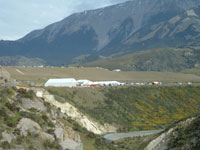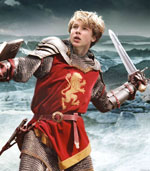Editor’s note: Drew Trotter, a theologian who frequently writes and lectures on film, had the privilege of visiting the movie set of The Lion, the Witch, and the Wardrobe in New Zealand last December. Trotter shares his observations in this exclusive story for Christianity Today Movies.
I arrive in Christchurch on a Sunday morning, too late for church, and drive on up to Arthur’s Pass where filming is in the final stages for The Lion, the Witch, and the Wardrobe.
Arthur’s Pass, about two hours up into the mountains above Christchurch, is a two-sides-of-the-highway-for-half-a-mile kind of town, and the significance of the town’s name doesn’t escape me. The myth of King Arthur shares much of the tragedy, glory and truth of C. S. Lewis’s Narnia tales. As I run out to a pay phone to call Tom Williams—the assistant to Mark Johnson, the producer who has given me permission to visit the set the next day—another pleasing omen occurs: Though it is almost New Zealand summer, a beautiful, light snow begins to fall, covering everything in a thin blanket of white.
Are the real environs of the movie location affected by the story of fictional Narnia? Does the threat of “always winter, never Christmas” exist here, too? More importantly, will Aslan appear to drive away the winter and bring the spring?

The next morning, I pass through the security gate and drive up the narrow road to the site. After meeting Williams and getting a tour of the base camp, we visit two of the three active sets at this location.
The first is where all the “green screen” filming is done. They use this huge tent mostly to film filler shots; today they are shooting a few fauns and centaurs making merry at the coronation celebration for the Pevensey children, after the Witch is defeated.
The next scene, on the battlefield where another unit is shooting the Witch’s army moving into position, is likewise inconsequential. And yet it will, like all such “secondary” scenes, make the movie feel real to the viewer. Throughout the morning, I reflect on the reality of the filmmaking process compared to what we will see on screen. I spend all morning watching scenes that, if they get into the film at all, will last no more than a few seconds of screen time, and will evoke little emotional response in the viewer. In reality, though, hundreds of people work for more than a day in order to get those few seconds of film into the can.
But what I see next is hardly just a “filler” scene. It’s a vital one.
On Top of the Mountain
Tom suggests that we hike up to the top of a nearby mountain where they are filming the hand-to-hand combat between Peter, played by newcomer William Moseley, and the White Witch, portrayed by veteran actress Tilda Swinton. In the book, this particular duel is barely mentioned in a paragraph describing Aslan arriving on the scene to save the day. The scene in the movie, however, will be elaborated significantly, as will the entire battle between the Witch’s army and Peter’s.

We arrive at the set, and several things strike me at once. Nearly 80 people are there, scrambling around among the rocks, with lighting equipment, electric generators, wires and cables of all sorts and props for the film, including swords, armor, and other battle paraphernalia. More surprising is how many people are there simply to help serve lunch, hold clipboards, or serve in some other capacity unrevealed during the afternoon. A large wooden platform built off to the side provides the landing area where the helicopter will bring in lunch for all of us. Earlier in the day, seven helicopters had flown the company to the top of the mountain, but I was glad we had hiked up. Being a little tired out made me feel more a part of the very physical action in the scene.
Knowing the high expectations for this film, I expected a tense atmosphere on the set. But talking to members of the crew and watching the filming of several scenes, I sensed no such tension. Everyone seemed free and easy, happy to be there, and well-assured of their role in the film. More than one person confidentially praised the director, Andrew Adamson, for his work with the actors, and with the children in particular. This endorsement is significant, since LWW is Adamson’s first live-action movie, though he did direct both of the acclaimed Shrek movies. Sitting beside him at lunch, and hearing him banter with everyone from the script girl to Swinton, the biggest “star” in the film, one gets the impression of the consummate leader: in charge, but truly loved by his troops.
The spectacular setting of the scene contributed to the peaceful atmosphere, too. When the crew broke for lunch, I was invited along to a buffet feast of lamb, asparagus, potatoes and bread pudding. We each found a place on the ground, looking out on the greenish brown hills and mountainsides, which contrasted beautifully with the rock and snow, and the brilliant blue, lightly clouded sky. The vistas, unencumbered by rocks or trees, revealed much higher, snow-capped peaks and deep, almost purple, shadowed valleys that seemed to go on and on. No wonder these mountains are named the New Zealand “Alps.”
The Witch’s Soft Side
The mutual respect between Adamson and his co-workers extended to other relationships on the set as well—especially between Swinton and Moseley. Swinton spent the afternoon with Moseley going over and over a tricky, technical fall that he was to do, when it looks like all is lost in their duel. After several brave parries in which Peter holds his own but is tiring fast, the Witch moves in for the kill. Peter stumbles backward, making himself even more vulnerable to her two gigantic swords (not the stone knife of Lewis’s book, by the way). The Witch then rises up to her full height—the book says she’s seven feet tall—and is set to run Peter through, when Aslan arrives and saves Peter’s life.

Swinton is a highly respected actress, well known in the film community for her edgy roles in films like Orlando and Young Adam. Actresses with her reputation often make demands and are rude to their fellow actors; Hollywood lore is full of such stories. But Swinton, without being condescending in any way, patiently discusses with Moseley suggestions for movements and actions, just as if he were her equal. And working with one of the best action choreographers in the business, Phil Neilson, they repeatedly rehearse their moves.
Time after time, they try new angles and new movements, but I don’t hear a single complaint or criticism, or even an impatient huff. The cast and crew’s patient respect for each other is palpable.
Several circumstances about the scene made it a situation where tempers could flare. The scene called for more rehearsal than usual, because the weapons weren’t the fake ones of longer shots, but the real—and dangerous—ones used in close-ups. Moseley is wearing heavy armor, and Swinton’s imposing dress is heavy and rough. Though she’s not wearing the six-inch platform shoes that bring her 6-foot-1 frame closer to the seven-foot witch of the book, the movements are still obviously difficult in the clothing both actors have to wear. The weather is cool enough, but the extra lighting needed for the scene adds more discomfort to the work.
None of this seems to matter, though, as grips, continuity assistants, director, stars and a host of others go on and on, working to get it right. I’m impressed by the professional attitude everyone seems to have about their job, and I later find out what’s behind it.
‘We Don’t Want to Fail’
Later in the day, I talk with one of the crew members back in the green screen tent about the professionalism, respect, and camaraderie I’ve seen on the set. And the reason becomes clear: Most of the people working on this movie—two glaring exceptions being Swinton and Johnson—had read the Narnia Chronicles as children and revere them as the powerful shapers of a child’s heart that they are.
“No one working on the film wants to make the mistake that people will point to later as evidence that the movie didn’t match up to the book,” the crew member told me. “We all love the story too much; we don’t want to fail.”
This is the way Narnia’s values invade our hearts; we love the story and are shaped by it, even when we don’t know all its details or realities. Cast and crew, director, producer, and stars all seemed to be working toward a goal that transcended their own cares of the moment, and they worked toward it with a respect and a desire that appeared grounded in the “magic from before the beginning of time.”
How could this not make a difference when The Lion, the Witch, and the Wardrobe hits theaters in December?
Drew Trotter is President of the Center for Christian Study in Charlottesville, Virginia. He is also a film critic who regularly lectures on film and culture at seminaries, churches and colleges throughout the eastern U.S.
Base camp photo by Drew Trotter; Moseley photo copyright © Walden Media; Swinton photo copyright © 2005 Disney Enterprises, Inc., and Walden Media, LLC.
Note: The Swinton photo is from the book, The Chronicles of Narnia: The Official Movie Companion, by Perry Moore, coming in November from Harper San Francisco, Publisher.
Copyright © 2005 Christianity Today. Click for reprint information.











